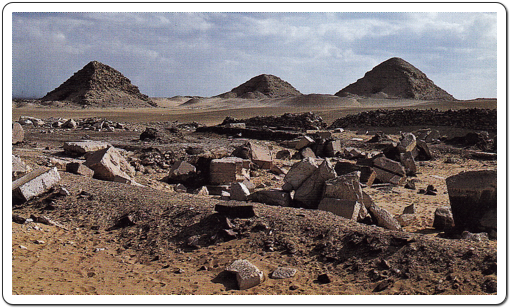Abusir is the Arab name for the Greek Busiris, which in turn is a rendering of the Ancient Egyptian name pr-wsir, which means House of Osiris. Its Ancient Egyptian name refers to Osiris, the god of the dead and resurrection and it is thus not surprising that Abusir was a part of the Memphite necropolis.
Abusir is located at a couple of kilometres north of Saqqara, but still at some distance to the south of Giza. Its three main surviving pyramids can easily be seen from the funerary complex of Horus Netjerikhet.

Interactive map of Abusir. Click the little circle to learn more.
Source: Lehner, Complete Pyramids, p. 142.
Royal interest in Abusir started with the reign of Userkaf, the first king of the 5th Dynasty, when he chose the site to built a remarkable and until then unique monument: a Solar Temple. Several of his successors would not only follow his example and build their own solar temples, they would also prefer this site for their burial.
The last solar temple was apparently built by Menkauhor, towards the end of the 5th Dynasty. Although Menhauhor's funerary monument has not (yet?) been found or identified, it also seems that with the last solar temple, the kings of Egypt lost interest in Abusir as a burial ground. The site continued to be used, however, by the Memphite nobility until the end of the pharaonic era.

The scanty remains of Userkaf’s Solar Temple at Abusir, with the pyramids of Sahure, Neferikare and Niuserre in the background.
Source: Lehner, Complete Pyramids, p. 149.
The first three pyramids that were built there, a couple of hundreds of metres to the south of Userkaf’s Solar Temple, had their northwest corner aligned on the same diagonal. This diagonal is believed to have pointed at Heliopolis, a city on the Nile’s east bank located to the northeast of Memphis and dedicated to the cult of the solar god.
Two royal pyramids break the diagonal alignment: the unfinished pyramid believed to have been started by Shepseskare somewhere halfway between Sahure's pyramid and Userkaf's Solar Temple; and the pyramid of Niuserre that was inserted between Sahure's and Neferirkare's pyramids in such a way that the unfinished causeway and Valley Temple that were intended for Neferirkare's monument were diverted to Niuserre's.
A small pyramid south of the pyramid of Neferirkare was probably intended as his satellite pyramid but works were halted, presumably at his death and the small pyramid was later on converted into a funerary monument for the queen-mother, Khentkaus II, with its own mortuary temple.
Two small pyramids to the east and southeast of Neferefre's pyramid need further examination. Thus far they are assumed to be queen's pyramids, but this is not certain and even if they were, it is not known for which queens they may have been built.
Several higher courtiers also moved along with their kings and had their mastabas built near the royal pyramids. The most famous example is that of the royal hair-dresser and vizier Ptah-shepses, whose mastaba features prominently between Sahure’s and Neferirkare’s monuments.
Other mastabas were built to the east of where Niuserre would later build his pyramid, forcing him to modify the layout of his mortuary temple; while others yet were built due east of Neferefre’s small and unfinished pyramid.
An important necropolis for the Memphite aristocracy has also been located to the west of the pyramid field. Here there were tombs dated to the 26th and 27th Dynasties that were found, showing that Abusir remained an important funerary site until the end of pharaonic times.